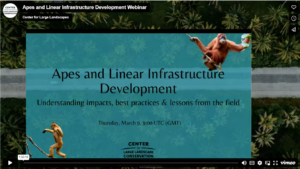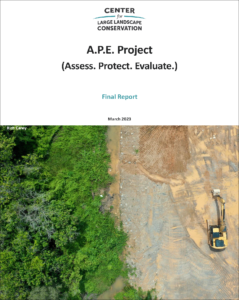Assess. Protect. Evaluate.
Assessing Linear Infrastructure Threats to Great Apes and Gibbons in Three Key Landscapes
As an international leader in connectivity conservation, the Center for Large Landscape Conservation advances large-scale conservation through science, policy, and network-building to avoid barriers to wildlife movement and reduce human-wildlife conflict. With support from the Arcus Foundation, the Center embarked upon the A.P.E. (Assess. Protect. Evaluate.) Project to address the threats of rapidly expanding linear infrastructure (LI) development to three endangered species in three key great ape and gibbon habitats in Africa and Asia:
- Gorillas, Transboundary Virunga (DRC, Uganda, Rwanda)
- Orangutans, Eastern Sabah, Borneo, Malaysia
- Hoolock gibbons, Northeastern India
The goal of A.P.E. was to increase capacity and deliver best practices to better equip scientists, LI developers, policy makers, conservation practitioners and civil society with the knowledge and tools to safeguard ape and gibbon populations. This will better protect local communities, forest habitats, and all wildlife species by promoting habitat connectivity and reducing ecological impacts from LI development.
The final report includes:
- Spatial analyses of these three landscapes, using satellite imagery with public data on roads and human developments and forest cover in ape ranges
- A literature review highlighting the current state of research and knowledge gaps concerning apes and linear infrastructure
- National policy reviews
- Recommendations for ways forward to mitigate the harmful effects of linear infrastructure and habitat fragmentation on apes and their ranges
A.P.E. Project Case Studies
 The A.P.E. Project team developed ten case studies that are a globally diverse collection of real-world best practices, projects, and lessons that aim to provide practitioners exemplary ways of protecting apes—and other species—from LI development.
The A.P.E. Project team developed ten case studies that are a globally diverse collection of real-world best practices, projects, and lessons that aim to provide practitioners exemplary ways of protecting apes—and other species—from LI development.
Several of the case studies examine canopy bridges as a solution to reduce wildlife-vehicle collisions and reconnect severed habitat.
Recorded Presentations
 The Center for Large Landscape Conservation coordinated and hosted the webinar “Apes and Linear Infrastructure Development,” during which experts shared a variety of solutions to address the impacts of LI on great apes and gibbons, with an emphasis on collaboration. They also discussed case studies highlighting the efficacy of canopy bridges and identified areas in need of further research.
The Center for Large Landscape Conservation coordinated and hosted the webinar “Apes and Linear Infrastructure Development,” during which experts shared a variety of solutions to address the impacts of LI on great apes and gibbons, with an emphasis on collaboration. They also discussed case studies highlighting the efficacy of canopy bridges and identified areas in need of further research.
 The A.P.E. Project was made possible through a generous grant from the Arcus Foundation.
The A.P.E. Project was made possible through a generous grant from the Arcus Foundation.
Questions about the A.P.E. Project? Please contact Dr. Megan Parker.
Photos, top to bottom: Hoolock Gibbon – Adobe Stock; Baby gorilla, Virunga – Adobe Stock.



